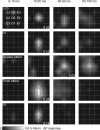Layer- and cell-type-specific suprathreshold stimulus representation in rat primary somatosensory cortex
- PMID: 17317752
- PMCID: PMC2075227
- DOI: 10.1113/jphysiol.2006.124321
Layer- and cell-type-specific suprathreshold stimulus representation in rat primary somatosensory cortex
Abstract
Sensory stimuli are encoded differently across cortical layers and it is unknown how response characteristics relate to the morphological identity of responding cells. We therefore juxtasomally recorded action potential (AP) patterns from excitatory cells in layer (L) 2/3, L4, L5 and L6 of rat barrel cortex in response to a standard stimulus (e.g. repeated deflection of single whiskers in the caudal direction). Subsequent single-cell filling with biocytin allowed for post hoc identification of recorded cells. We report three major conclusions. First, sensory-evoked responses were layer- and cell-type-specific but always < 1 AP per stimulus, indicating low AP rates for the entire cortical column. Second, response latencies from L4, L5B and L6 were comparable and thus a whisker deflection is initially represented simultaneously in these layers. Finally, L5 thick-tufted cells dominated the cortical AP output following sensory stimulation, suggesting that these cells could direct sensory guided behaviours.
Figures








Comment in
-
Observing without disturbing: how different cortical neuron classes represent tactile stimuli.J Physiol. 2007 May 15;581(Pt 1):5. doi: 10.1113/jphysiol.2007.132225. Epub 2007 Mar 22. J Physiol. 2007. PMID: 17379625 Free PMC article. No abstract available.
Similar articles
-
Spatiotemporal characteristics of neuronal sensory integration in the barrel cortex of the rat.J Neurophysiol. 2005 Mar;93(3):1450-67. doi: 10.1152/jn.00912.2004. Epub 2004 Oct 20. J Neurophysiol. 2005. PMID: 15496491
-
Sub- and suprathreshold receptive field properties of pyramidal neurones in layers 5A and 5B of rat somatosensory barrel cortex.J Physiol. 2004 Apr 15;556(Pt 2):601-22. doi: 10.1113/jphysiol.2003.053132. Epub 2004 Jan 14. J Physiol. 2004. PMID: 14724202 Free PMC article.
-
Modified sensory processing in the barrel cortex of the adult mouse after chronic whisker stimulation.J Neurophysiol. 2007 Mar;97(3):2130-47. doi: 10.1152/jn.00338.2006. Epub 2006 Nov 22. J Neurophysiol. 2007. PMID: 17122325
-
Similarity of direction tuning among responses to stimulation of different whiskers in neurons of rat barrel cortex.J Neurophysiol. 2005 Sep;94(3):2004-18. doi: 10.1152/jn.00113.2004. Epub 2005 Jun 22. J Neurophysiol. 2005. PMID: 15972836
-
Receptive field structure in cortical area 3b of the alert monkey.Behav Brain Res. 2002 Sep 20;135(1-2):167-78. doi: 10.1016/s0166-4328(02)00162-6. Behav Brain Res. 2002. PMID: 12356447 Review.
Cited by
-
Beyond Columnar Organization: Cell Type- and Target Layer-Specific Principles of Horizontal Axon Projection Patterns in Rat Vibrissal Cortex.Cereb Cortex. 2015 Nov;25(11):4450-68. doi: 10.1093/cercor/bhv053. Epub 2015 Apr 1. Cereb Cortex. 2015. PMID: 25838038 Free PMC article.
-
Stimulus intensity determines experience-dependent modifications in neocortical neuron firing rates.Eur J Neurosci. 2015 Feb;41(4):410-9. doi: 10.1111/ejn.12805. Epub 2014 Dec 26. Eur J Neurosci. 2015. PMID: 25546174 Free PMC article.
-
Morphological Characteristics of Electrophysiologically Characterized Layer Vb Pyramidal Cells in Rat Barrel Cortex.PLoS One. 2016 Oct 5;11(10):e0164004. doi: 10.1371/journal.pone.0164004. eCollection 2016. PLoS One. 2016. PMID: 27706253 Free PMC article.
-
Delayed and Temporally Imprecise Neurotransmission in Reorganizing Cortical Microcircuits.J Neurosci. 2015 Jun 17;35(24):9024-37. doi: 10.1523/JNEUROSCI.4583-14.2015. J Neurosci. 2015. PMID: 26085628 Free PMC article.
-
Activity in the barrel cortex during active behavior and sleep.J Neurophysiol. 2010 Apr;103(4):2074-84. doi: 10.1152/jn.00474.2009. Epub 2010 Feb 17. J Neurophysiol. 2010. PMID: 20164403 Free PMC article.
References
-
- Ahissar E, Sosnik R, Bagdasarian K, Haidarliu S. Temporal frequency of whisker movement. II. Laminar organization of cortical representations. J Neurophysiol. 2001;86:354–367. - PubMed
-
- Ahissar E, Sosnik R, Haidarliu S. Transformation from temporal to rate coding in a somatosensory thalamocortical pathway. Nature. 2000;406:302–306. - PubMed
Publication types
MeSH terms
Substances
LinkOut - more resources
Full Text Sources
Other Literature Sources

